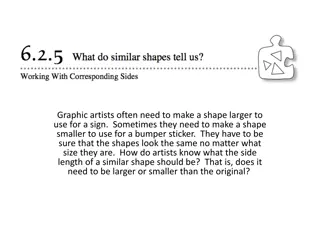Importance and Types of Scale in Architecture
Scale is crucial in architecture for accurate designs and execution. Standard scales are used in architectural drawings to set object sizes, such as human scale and miniature scale. Human scale relates to human dimensions, while miniature scale reduces object sizes. Understanding these scales enhances architectural composition and aesthetics.
Download Presentation

Please find below an Image/Link to download the presentation.
The content on the website is provided AS IS for your information and personal use only. It may not be sold, licensed, or shared on other websites without obtaining consent from the author.If you encounter any issues during the download, it is possible that the publisher has removed the file from their server.
You are allowed to download the files provided on this website for personal or commercial use, subject to the condition that they are used lawfully. All files are the property of their respective owners.
The content on the website is provided AS IS for your information and personal use only. It may not be sold, licensed, or shared on other websites without obtaining consent from the author.
E N D
Presentation Transcript
IMPORTANCE & TYPES OF SCALE IN ARCHITECTURE Standard Scales for Architectural Drawings: Scale is referred to as the ratio of the size of the object to the actual size of the object. It gives the actual size or dimension of an object or building. The term scale can also be referred to as the instrument used to measure the various objects or forms. The units of scale are feet ( ), inches ( ), metre (m), centimetre (cm), millimeter (mm), etc. Scale in Architecture plays a vital role in the design process and execution.
Standard Scales for Architectural Drawings has a lot of importance:- 1. Before planning for a building, the scale needs to be set to make the work easy. 2. With the use of scale, the sizes of the objects are set as; it is to be made in miniature scale, human scale or architectural/monumental scale. 3. With the setting of a correct scale, the composition becomes more accurate and aesthetically pleasing. 4. The architect uses the miniature scale for making his drawings on the paper and for making models. 5. With due reference to the scales, the sizes of the forms are set in a monument. 6. In the case of Taj Mahal or Humayun Tomb, the monumental scale was set to make it look more pleasing and to consider it as a monument. Types of Standard Scales for Architectural Drawings: Various Scales which Architects use in their daily life are Human Scale It is defined as the scale with reference to the human dimensions and all the sizes of the objects are set accordingly. We may say it as the scale of all the objects and the buildings used for daily purpose. All the sizes are convenient and handy in accordance to the people living in the building. The sizes of chairs, tables, staircase treads and risers, doors, windows; all are set according to the human dimensions and their use.
The human scale in architecture can be explained with the height of the building by giving reference to the human dimensions and human scale. It can also be explained by the use of various other features and elements such as colors, textures, size of windows and doors etc. In case, if dark colors are used in a room, then it looks to be more smaller than compared to the use of light colors. Large windows make room look bigger as compared to the smaller windows which make the room look smaller. Textured walls are used in the big halls or rooms to get a feel of nearness in room. The textured walls enhance the beauty and helps in feeling the less distance between two objects or walls of room. The best examples for human scales are houses and automobiles which we use are built in this scale. Miniature Scale When the scale of the object is set in such a manner that the size of the object or building decreases from the actual size then it is termed as miniature scale. Architects use it for making plans and models. It is also used by the miniature artists to derive various forms and sculptures. In our daily life if we want to compare then the small ant is in miniature scale to the human being. In case of model making, the actual dimensions are reduced to make appropriate models. Madurodam Miniature Park near Rotterdam is a best example of miniature scale. It is 1:25 live scale model replicas of the beautiful cities of Holland.
Monumental Scale When the size of the object or a building gets increased than the actual size then it is termed as monumental scale. The scale is much bigger than human scale and generally used for public places. The places where large crowds gather such places need to be constructed on monumental scale. The Buland Darwaza is in monumental scale, because its size is far-far bigger than the actual human dimensions. The Taj Mahal is also constructed in monumental scale so as to give the feel of grandeur. Vision Scale or Architectural Scale It is not the actual scale. It is the size of the object seen with reference to the object around it. In case of the elevation of the house, the height of windows and doors defines the height of the building and hence is set according to the architectural scale. The architectural standards are set and accordingly the scale is set for them. The fa ade made in this scale makes the composition more aesthetic and pleasing.
Article Source: https://archistudent.net/importance-types-of-scale-in-architecture/























